Your complete guide to catch speckled trout under diving birds: best time to fish them, where to find them and best techniques to use.
More...
When, Where & How To Fish For Speckled Trout Under Diving Birds
It's common knowledge that diving birds are a dead giveaway of great speckled trout (or redfish) action.
People make it sound so easy: All you have to do is find some birds circling in the air and you're guaranteed a great fishing trip.
But it's not so easy, and if you've spent any amount of time fishing every pile of birds you saw you've quickly learned what a let down they can be.
So, if you're up for doing a little bit of learning then you stand to gain the kind of expert fishing knowledge on diving birds that takes most inshore anglers years to learn, if they ever do at all.
But be warned! This is an ultimate guide, so you may want to bookmark this page and return where you left off.
Now, let's get started with the definition of fishing the birds:
What exactly are "diving birds" in inshore fishing?
The term "diving birds" simply refers to birds diving to catch baitfish driven to the water's surface by feeding predator fish.
The birds can be pelicans, seagulls, or terns, the bait can be shrimp, shad or menhaden, and the predator fish can be speckled trout, redfish, and other saltwater species.
There are many combinations of bird, bait and fish to be had, so we will cover all of them so you know what to look for (and what to avoid).
Also, keep in mind that the focus of this guide is speckled trout, but we will touch on other species since you will inevitably encounter them on your fishing trips.
The Right Kind Of Diving Bird
Let's establish the fact that not all diving birds are good for catching speckled trout.
In fact, more than one kind will lead to a bunch of bad fishing, or a whole other species altogether.
So, the specific species you want to see in order to catch speckled trout under diving birds is the laughing gull.
Not brown pelicans or terns.
This species is pretty common and you ought to immediately recognize them.
Laughing Gulls Must Be Diving Like This
Used to, I'd immediately run to the first sign of speckled trout under diving birds without paying any real attention to exactly what they're doing.
Well, that has proven to be a mistake, one that wasted time and sometimes caused me to lose my fishing spot.
Experience has proven that bird behavior can be deceptive, so use this criteria diving birds have to meet to justify you changing direction or leaving your fishing spot:
1. There needs to be a lot of them
When a laughing gull finds shrimp, he doesn't keep it to himself and couldn't if he tried.
All his buddies will join the feast, especially if there's plenty bait to go around.
If there's not, then why would they stick around?
You're bound to catch speckled trout under diving birds when there's a small air force of them.
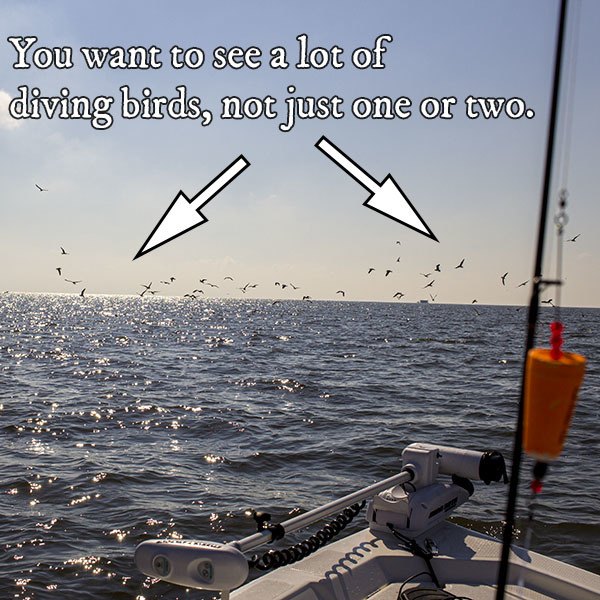
With that said, there have been fishing trips where we caught a good deal of speckled trout under what was only five to ten diving birds.
Ultimately, it's up to you to decide to make a few casts or not.
2. They must dive with confidence
You need to see the seagull dive into the water like a crash test dummy going for a brick wall.
Not nitpicking. Confident diving.
If a bird looks unsure then he is probably just as unsure as you are.
3. Look for bait in their mouths
If you don't see shrimp (or whatever bait they're diving on) taking a ride in their beaks, then you shouldn't stick around.
4. You must see shrimp jumping
If shrimp are choosing the lesser evil of the seagull, there must be a greater evil beneath (hopefully speckled trout).
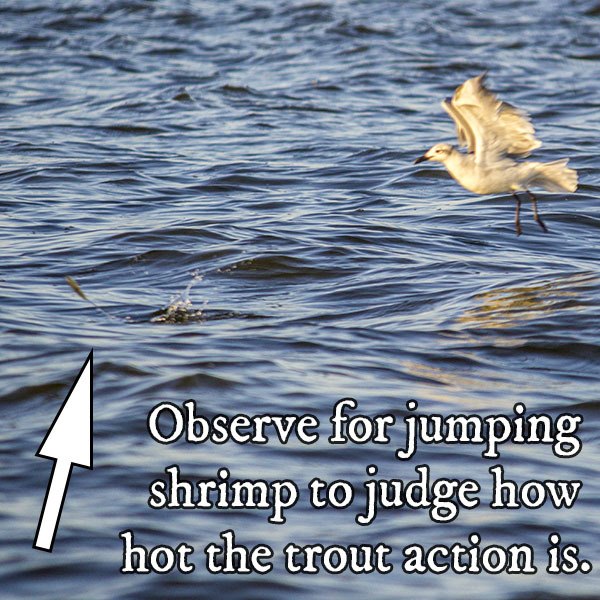
How To Fish Speckled Trout Under Diving Birds
Now that you know what kind of bird to look for, let's go over how to fish them:
Where To Put Your Boat
Where you want to put your boat depends on whether the flock of birds is moving or stationary.
Sometimes bait is moving with the current in a tidal highway so – naturally – seagulls move with it.
Other times seagulls are stationary and don't move at all.
Either way, the idea is to position the boat so you can do two things:
- make quality casts to where the birds are diving
- not accidentally "run over" the birds (or let them overtake you)
Fishing Stationary Diving Birds
This one is easy!
All you have to do is anchor down so that the side of the boat is facing them and the wind is to your back.
This way it's easy to make quality casts to them.
You can look at this article about boat positioning to get a better idea of what I'm talking about.
The infographics you'll find there do a great job of illustrating this technique!
Positioning On A Moving Flock Of Diving Birds
You're doing – more or less – the same thing described above with the exception that you must account for a couple more things:
- direction of the birds
- direction of the boat
In case it's not obvious, anchoring really isn't the best option in this scenario because you won't have much time to set up and, at best, will only get a few quality casts in before the birds move out of casting range.
It's best to use a trolling motor to stay with them and, when you do, you must make a point of not getting in front of the birds so they can't overtake you (trust me, it can happen) and not get directly upwind or up current (whichever force is strongest) so that your boat does not drift over where the fish are feeding.
Sometimes the conditions work against you and repositioning the boat will be part of the effort to stay with the birds.
Use This Fishing Tackle To Catch Speckled Trout Under Diving Birds
We'll keep this brief and to the point, as there are plenty of tackle-related guides for you to browse.
What you want to be throwing at diving birds really depends on your level of skill.
I personally feel that throwing a jig on casting tackle is best because it enables you to cast faster and more accurately than spinning tackle.
That's a fact and I'm more than happy to talk about it in the comments below.
But, if you're not confident with casting tackle, consider throwing a Double Rig, which is really just two jigheads tied onto leader line.
Learn how to tie one at this link.
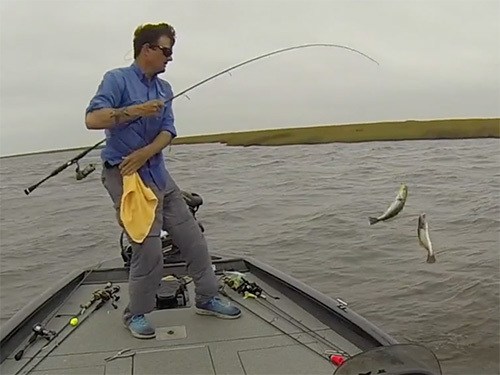
I've used the Double Rig to lay righteous smackdowns on trout over the years, catching two trout at a time all the way to a limit!
Last but not least, there is the time-tested Inshore Rig. This is also good to throw if that's all you have tied on.
Tackle You Should Definitely NOT Use
First off, there is zero need to use live bait.
It takes too long to rebait and is totally besides the point because the live bait you need is already in the water.
When you fish speckled trout under diving birds you are fishing speckled trout feeding so ravenously that they will hit anything entering the water.
Considering this, you want to use something that is durable, economical and will get their attention.
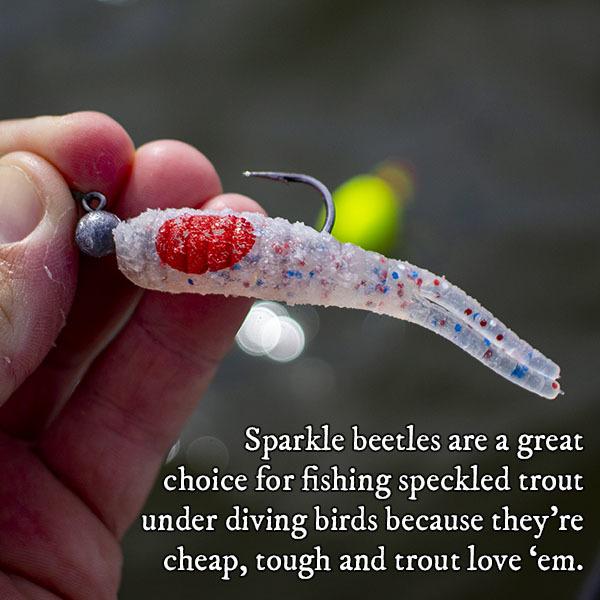
Matrix Shad in Ultraviolet is a great choice, but so are white or chartreuse colored sparkle beetles.
Pro Tip: Threading them onto a jighead with a dab of superglue goes a long way!
Avoid Treble Hooks As Terminal Tackle When Fishing Speckled Trout Under Diving Birds
Some people find treble hooks appealing because they perceive that it will help them hook and land more fish.
But, when it comes to fishing speckled trout under diving birds, that could not be further from the truth; these reasons explain why:
Reason #1: Unhooking speckled trout takes longer. That's time your bait is not in the water and – if your bait isn't in the water – you can't catch a fish.
A single hook buttons up just as well and is far easier to get free (and back to biting fish).
Reason #2: It's bad for releasing fish. Treble hooks cause the highest mortality rate among fish, whether you are playing catch and release or throwing back an undersized fish.
Reason #3: They tangle more than single hooks. The drawback to this is obvious.
Reason #4: They're not as versatile as single hooks, and can't rig soft plastics in a pinch like a single hook can.
Exceptions For Use Of Treble Hooks
It happens often enough that you'll catch smaller-sized speckled trout that aren't long enough to keep.
When this happens, try throwing a topwater lure.
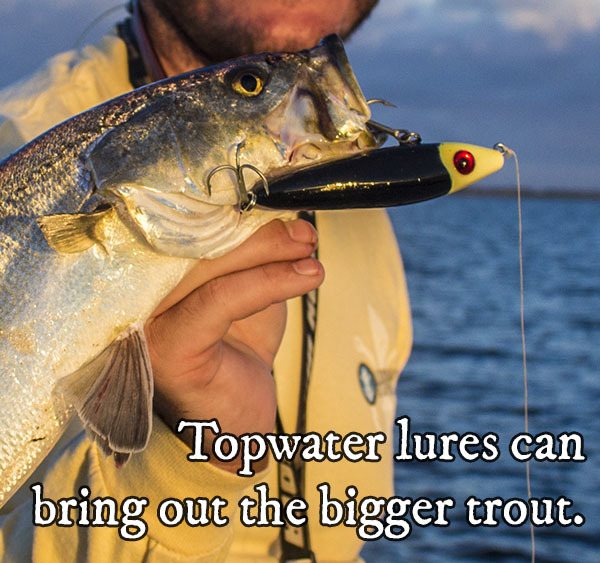
The profile and surface action of a topwater is more enticing to larger speckled trout, and such a lure is more difficult for throwbacks to get hooked on.
When To Leave Diving Birds
You should leave diving birds for the same reasons you would leave any fishing spot: you only catch trash fish or nothing at all.
If you feel like you got a few good casts in, and don't catch speckled trout (or whatever you're targeting) then it's time to go, even if everything looks too good to be true.
Additional Details To Catching Speckled Trout Under Diving Birds
This wouldn't be an ultimate guide without covering some of the finer points of fishing the birds, so let's go over them one by one.
Sitting Birds
These are birds that do exactly that: sit on the surface of the water.
They indicate that there was (or is about to be) good fishing action, they are just waiting for the bait to make its appearance.
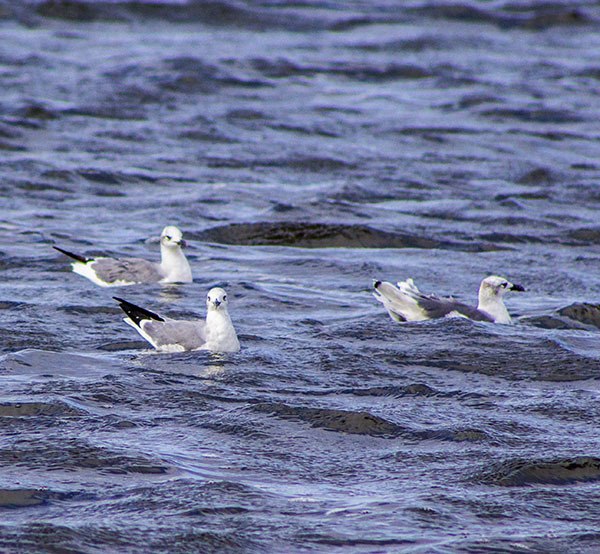
Or there could be biting fish under them, there just isn't any bait present to be driven to the surface for the seagulls to feed on.
You can drop a waypoint to fish them later, or stop to make a few casts and see what happens.
Roosting Birds
These are birds congregated on islands or rock jetties, usually during the summer, and just because there's a lot of them in the area does not indicate there's any good fishing action or bait nearby.
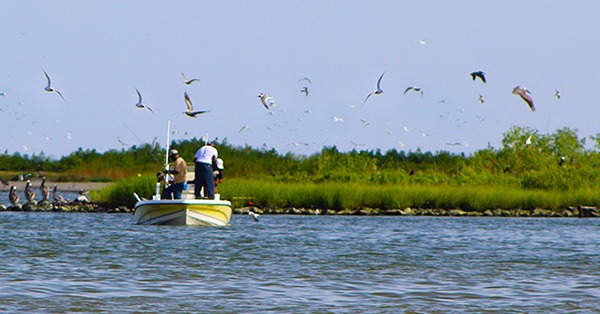
This is Breton Island, and these birds are laying eggs and raising their young here. Therefore they are not an indicator of good trout action (though that destination is popular for speckled trout).
Bycatch Birds
Whenever you see diving birds it is good to take a moment to scan the horizon for a commercial fishing boat that may have recently rolled through.
Shrimp boats will toss bycatch from their nets into the water, leaving an easy meal for birds.
Because that bait wasn't driven there by feeding predator fish (such as speckled trout or redfish) you will not find any good fishing action there.
The same applies to boats fishing crab and menhaden.
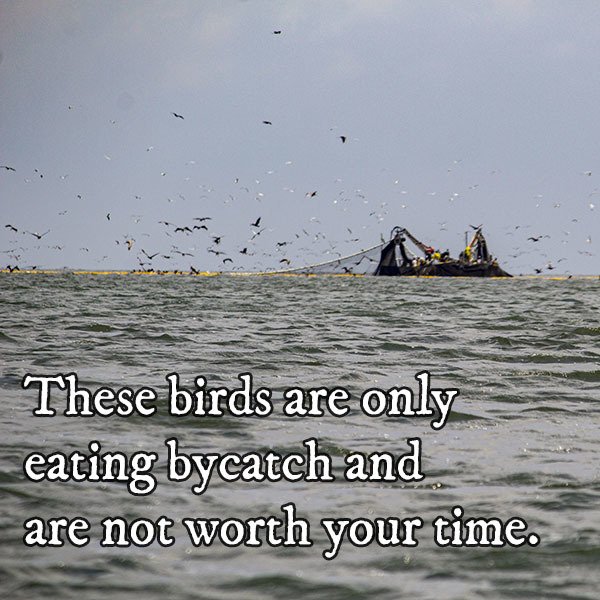
Prop Wash Birds
These are birds behaving in the same manner as bycatch birds, but instead of feasting on refuse they are picking off anything that could have been killed or stunned by the large propeller wash of a tug or crew boat.
Casting a line under them is just as futile as fishing bycatch birds.
What are liar birds?
These are terns, and not the "right" kind of bird you want to fish (laughing gulls).
Fishing under them usually only yields trash fish like ladyfish, hardhead and gafftop catfish.
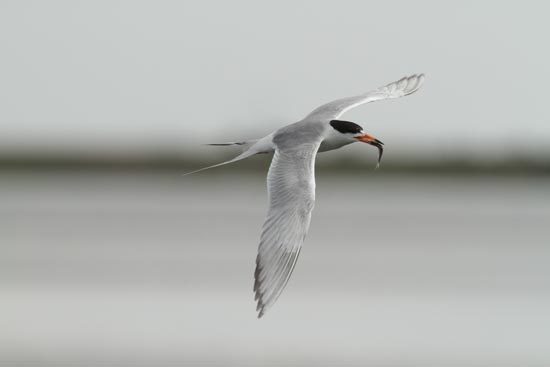
Sometimes you can catch bull reds under them during the months of August and September, but not often enough you can depend on it.
Terns are easy to identify because they are smaller and have pointier wings than other birds.
They also tend to hover, whereas not all birds do.
One Important Exception For Liar Birds
It's commonly accepted that liar birds are no good to fish, no matter the circumstance.
However, this isn't the case year-round.
Liar birds can produce good action during the winter pattern, when most of the bait is gone from the marsh and water has cleared significantly.
You'll find potbelly minnows beneath these birds, and speckled trout love eating them!
Fish Caught Besides Speckled Trout Under Diving Birds
Speckled trout aren't the only fish you'll have fun catching!
As mentioned earlier, there are less desirable species such as sail cats and ladyfish, but there are others such as:
- redfish
- white trout
- jack crevalle
- spanish mackerel
I'll admit we see spanish mackerel less and less due to the major spillway openings and high river levels from 2016 to 2018.
However, in the freshwater side of the marsh it's not uncommon to find schools of bass under diving birds as well.
Laughing gulls can dive on top of redfish and jack crevalle, but so can terns.
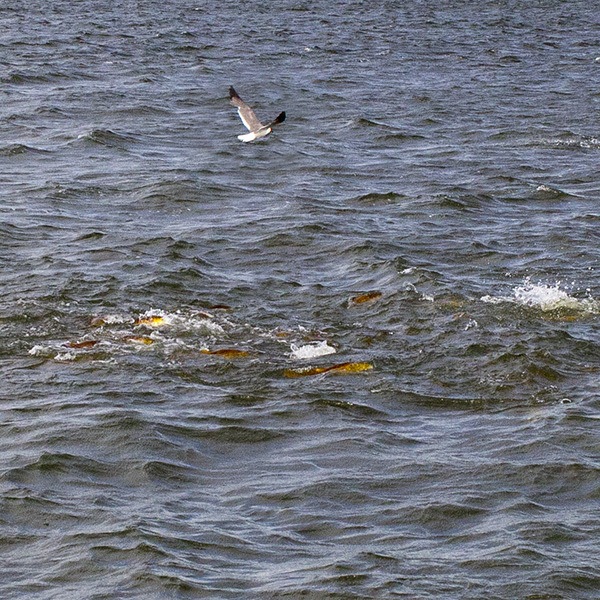
These redfish are chasing gizzard shad in open water, which move much faster than shrimp, so flocks of birds are always on the move and you may not see many, like in this picture. However, the amount of redfish breaking the surface is a dead giveaway.
So it's worth noting that Lake Pontchartrain and Lake Borgne near Slidell, Louisiana are both great locations for summertime jacks and redfish.
Location & Timing of Diving Birds
Yep, that's right.
With a total understanding of the tide, life cycle of shrimp and a little planning you can find this kind of fishing opportunity in the marsh.
I did it in this fishing trip, as well as many others. Keep reading and you'll see how!
Best Time Of Year To Catch Speckled Trout Under Diving Birds
The fall and spring are great to catch speckled trout under diving birds because those times coincide with the white and brown shrimp migrations, respectively.
After that, you can find good action during the summer and, after that, during the winter.
The Best Locations To Fish The Birds
The best place to begin looking is anywhere water flows the strongest, essentially a tidal highway like a large pass or the mouth of a major bayou.
These are where you can find shrimp flowing and – if you'd like detailed information – it is strongly recommended you read this article about that very topic.
Over To You
Congrats! You're done reading this ultimate guide to catching speckled trout under diving birds.
It's a lot of knowledge to take in at once, so I recommend you bookmark this page and return here after spending some time on the water putting it to use.
Hopefully you enjoyed this guide and, if you'd like more expert fishing knowledge like it, I strongly recommend you sign up for my newsletter.

Laughing gulls have white and black heads depending on their plumage. Generally, they are the only seagull diving on shrimp. The key is to avoid terns.
Are laughing gulls the ones with black heads or white?
I know it! Been there and done that. It happens.
I was fishing under birds today, unfortunately, I tangled my line with a seagull. Took me 30 minutes to reel it in, confine it with a net and cut away the hook and line
Hey Bruce, thanks for commenting.
I’m not sure how many birds are still diving on shrimp, as usually this time of year the shrimp migration is nearly over.
However, there is a free course on this called Fall Fish Location that I think you may enjoy:
https://www.lafbelite.com/course/easily-locate-speckled-trout-redfish-during-the-fall-pattern/
And there’s another free course called Winter Fishing Success that’s more timely for this time of year (winter):
https://www.lafishblog.com/wfs/
Enjoy!
Great information! Hopefully I can learn from this article!!